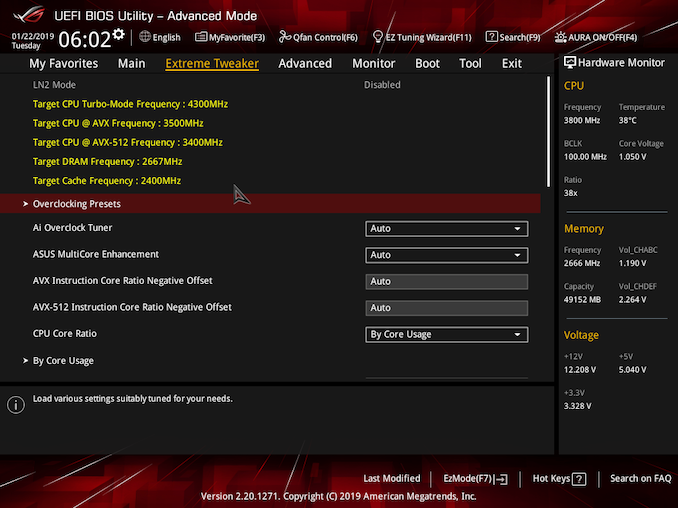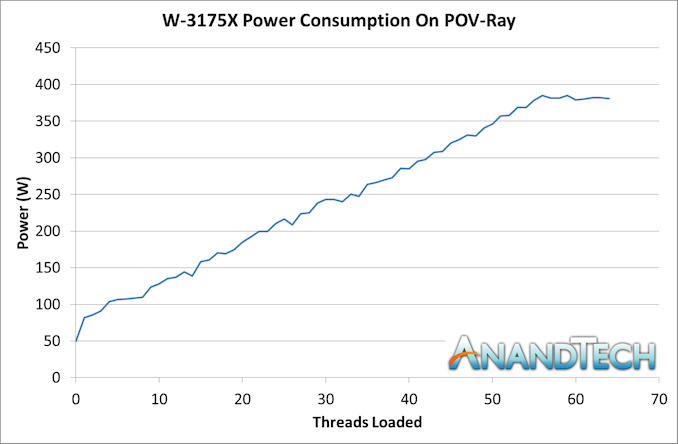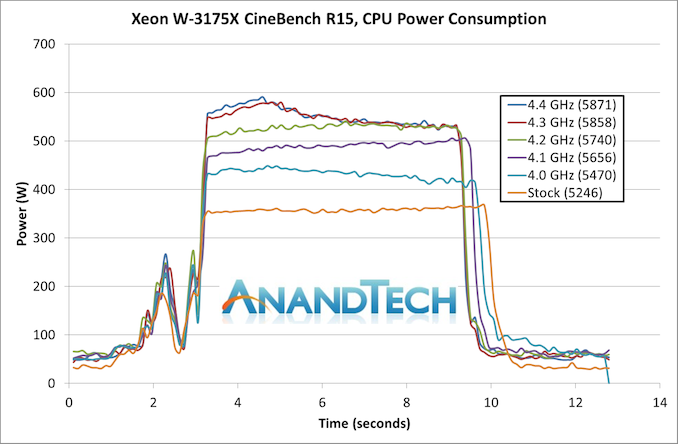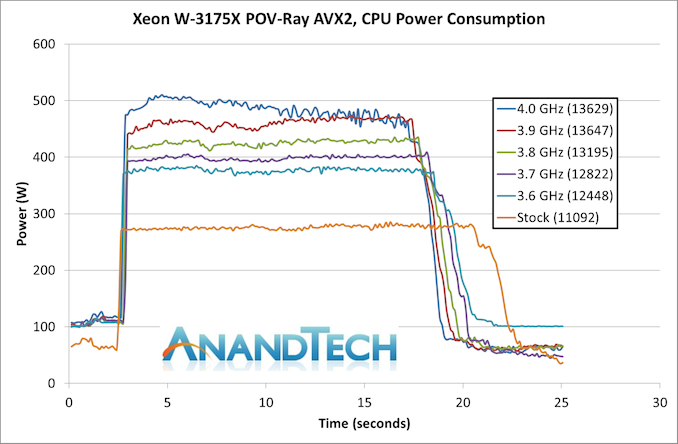The Intel Xeon W-3175X Review: 28 Unlocked Cores, $2999
by Ian Cutress on January 30, 2019 9:00 AM ESTPower Consumption and Overclocking
When Intel did a little demo at Computex 2018, with 28 cores all running at 5.0 GHz, we eventually found out that the system needed a 1700W water chiller to stay cool. Even at that point, people were wondering exactly how much power this CPU would put out. Then later in the year, Intel declared that the newly named Xeon W-3175X would be rated at 3.1 GHz for a 255W TDP. That makes it Intel’s highest TDP chip for a non-server focused processor. Just don’t ignore the fact that it has a 3.8 GHz all-core turbo frequency, which will push that 255W TDP through the roof.
Speaking with Intel before this review, they gave us two numbers of ‘power limits’. Intel defines two power limits for this processor: the PL1 or ‘sustained’ power limit, at 255W, and a PL2 or ‘turbo’ power limit at 510W. Normally Intel sets the PL2 at only 25% higher, but this time around, it’s a full 100% higher. Ouch.
This is only a limit though – processors can (and have) run well below this power limit, so we actually need to do some testing.
Per Core Turbos
As always with new Intel processors, we ask the company how the turbo ratios change as more cores are loaded. They used to give this information out freely, but in recent consumer launches no longer offer this info, despite it being available directly from the chip if you have one to put in a system. As a result, we have the following turbo values:
| Intel Per Core Turbo Values (SSE) | |||||||
| Cores | 2 | 4 | 8 | 16 | 18 | 24 | 28 |
| Xeon W-3175X |
4.3 GHz | 4.1 GHz | 4.0 GHz | 4.0 GHz | 4.0 GHz | 4.0 GHz | 3.8 GHz |
| Core i9-7980XE |
4.4 GHz | 4.0 GHz | 3.9 GHz | 3.5 GHz | 3.4 GHz | ||
The top 4.3 GHz turbo frequency is 4.3 GHz, which within eight cores goes down to 4.0 GHz. That frequency is kept all the way until >24 cores are loaded, where it sits at 3.8 GHz. With these big chips, usually a system needs a few cores or all the cores, so expect to sit around 4.0-3.8 GHz most of the time.
Intel did give us all-core ratios for AVX2 and AVX512 as well, at 3.2 GHz and 2.8 GHz respectively, however the ASUS motherboard we used had other ideas, setting these values at 3.5 GHz and 3.4 GHz which it said was ‘Intel POR (specification)’.
If you want to read our discussion on what Intel’s TDP values actually mean, here’s a handy guide we wrote late last year.
The ASUS BIOS: The Key to Power and Overclocking
One of the issues stemming from last year’s high-powered CPU reviews was the matter of Intel specifications. Simply put, while Intel has a list of suggested values for certain settings, motherboard manufacturers can (and often) do what they want for consumer systems, including lots of turbo, higher power consumption, and higher-than-expected defaults. Motherboard vendor features like Multi-Core Acceleration and Multi-Core Turbo are sometimes put at default, making testing a chip all the more tricky – should we test out of the box performance, or Intel specification performance (which isn’t always fixed anyway)?
For this new platform, ASUS has made it simpler, yet more confusing. They are still using the Multi-Core Enhancement option in their BIOS, or MCE for short, however the way it works has changed.
It offers two modes: Disabled, or Auto. When in Disabled mode, it puts all the options in ‘Intel POR’ mode, or Intel’s recommended settings. This includes voltages, frequencies, current limits, and removes all of ASUS’ independent tweaks for stability and performance. When in Auto mode, it opens up the power limits and the current limits, and sets the system up for overclocking. It doesn’t actually change any of the frequencies of the system, but just opens a few doors.
We spoke with Intel about this. They said ‘we recommend Intel specifications’, however despite this the company sent me this system with ASUS’ additional tweaks and geared for overclocking. If that isn’t confusing, I don’t know what is.
Intel’s MCE setting, among other things, does two very important changes:
- Changes the maximum temperature from 85ºC to 110ºC
- Changes the reported current
The first change gives the CPU some headroom before the system thermally throttles. Most Intel CPUs have a temperature limit of 95ºC, however this chip has a limit of 120ºC, so this can make a lot of sense, especially as a system ages and dust gets everywhere, reducing performance.
The second change might seem a little odd. Why does the reported current need changing? The issue here is that for the firmware, the underlying Intel system is relying on some older reporting code when dealing with current limits. In order for this high current processor to not be automatically throttled by this code, a divider is put in place.
Intel’s ‘recommended’ divider is 1.28, however ASUS’ tweaked setting puts this divider at 4, which opens up some headroom for overclocking. One of the downsides to this is that it causes confusion for any software that reports power numbers, such as Intel’s Power Gadget and AIDA64. (AI Suite automatically corrects for this.) ASUS states that when the setting is at 4, the actual power value reported by the processor is 2.25x the value it gives. Thus if the processor says 100W, it is actually drawing 225W. This corrective factor has been made in all our subsequent graphs.
Power Consumption
So here we go into actual hard power numbers. For this test we run our affinity scaling script to test the power consumption as we increase the threads. We’re using MCE enabled here, which doesn’t affect frequency but should allow for a full turbo, as we normally see on consumer processors.
At full all-core frequency in that higher power mode, we don’t reach 510W, but we certainly go well beyond 255W, scoring about 380W maximum. If we apply this to the Intel Spec version, and compare to other CPUs, we get the following:

Overall, that’s a lot of power. But that’s what we expected, right? The cooling used on this system has an apparent rating of 500W, so we’re just about happy with that.
Overclocking
So how do you push the limits on a system where the limits are already being pushed? Easy, push harder – as long as you don’t break it.
We haven’t had time for a full run of our benchmark suite in overclocked mode yet, however we were able to record some results and some power values. They key parts to chips like this is how we manage AVX2 and AVX512 ratios – normally users just set an ‘all-core turbo’ to some value as an overclock, but for this chip the AVX ratios need to be systematically lower in order to keep the system stable based on how much extra current they need.
So starting with MCE enabled to open up the power limits, the current limits, and the temperature limits, I probed the standard all-core turbo and the AVX2 turbo separately. In each instance, I didn’t change any setting other than the CPU multiplier, and increased the values. When the system booted, I ran Cinebench R15 for non-AVX and POV-Ray for AVX2, using Intel’s power gadget to take both power, frequency, and temperature values.
Starting with non-AVX testing, I raised the frequency from 4.0 GHz up to 4.4 GHz. The benchmark result scaled from stock frequencies up to 4.3 GHz, however it was clear that we were hitting thermal limits as the sensor was reading 110ºC, which felt really uncomfortable. Here are the power traces for those tests, along with the score:
At 4.3 GHz, we were hitting almost 600W peak load (confirmed by wall meter), which is the limit of the cooling setup provided. Compared to the 4.0 GHz result, we calculated that the CPU actually used 17% more power overall to get a 7% increase in performance.
With AVX2, we started much lower, at 3.6 GHz, again raising the frequency by 100 MHz at a time and recording the POV-Ray run with our software tools.
Here the power is overall a bit lower, but we can see that the score isn’t rising much at 4.0 GHz, again due to our CPU temperature sensor showing 110ºC very easily. In this instance, the power consumption between 3.9 GHz and 3.6 GHz increased by 14%, while the score rose 10%.
Intel sent an EKWB Phoenix cooler which is rated for much higher power consumption, but arrived too late for our testing. We’re planning on doing an overclocking review, so this should help. But what our results show is that when Intel showed that 5.0 GHz demonstration using a water chiller they really did need it. Users might look into investing in one themselves if they want this chip.
But What About That 5.0 GHz? How Much Power?
We took some of our benchmark values for power and frequency, extrapolated them with a power curve, and we estimate that at 5.0 GHz, this chip is likely to be drawing in excess of 900W, perhaps as high as 1200W. Yes, Intel really did need that 1700W water chiller.














136 Comments
View All Comments
Kevin G - Wednesday, January 30, 2019 - link
For $3000 USD, a 28 core unlocked Xeon chip isn't terribly bad. The real issue is its incredibly low volume nature and that in effect only two motherboards are going to be supporting it. LGA 3647 is a wide spread platform but the high 255W TDP keeps it isolated.Oddly I think Intel would have had better success if they also simultaneously launched an unlocked 18 core part with even higher base/turbo clocks. This would have threaded the needle better in terms of per thread performance and overall throughput. The six channel memory configuration would have assisted in performance to distinguish itself from the highend Core i9 Extreme chips.
The other aspect is that there is no clear upgrade path from the current chips: pretty much one chip to board ratio for the life time of the product. There is a lot on the Xeon side Intel has planned like on package FGPAs, Omnipath fabric and Nervana accelerators which could stretch their wings with a 255 W TDP. The Xeon Gold 6138P is an example of this as it comes with an Arria 10 FPGA inside but a slightly reduced clock 6138 die as well at a 195 W TDP. At 255 W, that chip wouldn't have needed to compromise the CPU side. For the niche market Intel is targeting, a FPGA solution would be interesting if they pushed ideas like OpenCL and DirectCompute to run on the FPGA alongside the CPU. Doing something really bold like accelerating PhysX on the FPGA would have been an interesting demo of what that technology could do. Or leverage the FGPA for DSP audio effects in a full 3D environment. That'd give something for these users to look forward to.
Well there is the opportunity to put in other LGA 3647 parts into these boards but starting off with a 28 core unlocked chip means that other offering are a downgrade. With luck, Ice Lake-SP would be an upgrade but Intel hasn't committed to it on LGA 3647.
Ultimately this looks like AMD's old 4x4/QuadFX efforts that'll be quickly forgotten by history.
Speaking of AMD, Intel missing the launch window by a few months places it closer to the eminent launch of new Threader designs leveraging Zen 2 and AMD's chiplet strategy. I wouldn't expect AMD to go beyond 32 cores for Threadripper but the common IO die should improve performance overall on top of the Zen 2 improvements. Intel has some serious competition coming.
twtech - Wednesday, January 30, 2019 - link
Nobody really upgrades workstation CPUs, but it sounds like getting a replacement in the event of failure.could be difficult if the stock will be so limited.If Dell and HP started offering this chip in their workstation lineup - which I don't expect to happen given the low-volume CPU production and needing a custom motherboard - then I think it would have been a popular product.
DanNeely - Wednesday, January 30, 2019 - link
Providing the replacement part (and thus holding back enough stock to do so) is on Dell/HP/etc via the support contract. By the time it runs out in a few years the people who buy this sort of prebuilt system will be upgrading to something newer and much faster anyway.MattZN - Wednesday, January 30, 2019 - link
I have to disagree re: upgrades. Intel has kinda programmed consumers into believing that they have to buy a whole new machine whenever they upgrade. In the old old days we actually did have to upgrade in order to get better monitor resolutions because the busses kept changing.But in modern times that just isn't the case any more. For Intel, it turned into an excuse to get people to pay more money. We saw it in spades with offerings last year where Intel forced people into a new socket for no reason (a number of people were actually able to get the cpu to work in the old socket with some minor hackery). I don't recall the particular CPU but it was all over the review channels.
This has NOT been the case for Intel's commercial offerings. The Xeons traditionally have had a whole range of socket-compatible upgrade options. It's Intel's shtick 'Scaleable Xeon CPUs' for the commercial space. I've upgraded several 2S Intel Xeon systems by buying CPUs on E-Bay... its an easy way to double performance on the cheap and businesses will definitely do it if they care about their cash burn.
AMD has thrown cold water on this revenue source on the consumer side. I think consumers are finally realizing just how much money Intel has been squeezing out of them over the last decade and are kinda getting tired of it. People are happily buying new AMD CPUs to upgrade their existing rigs.
I expect that Intel will have to follow suit. Intel traditionally wanted consumers to buy whole new computers but now that CPUs offer only incremental upgrades over prior models consumers have instead just been sticking with their old box across several CPU cycles before buying a new one. If Intel wants to sell more CPUs in this new reality, they will have to offer upgradability just like AMD is. I have already upgraded two of my AM4 boxes twice just by buying a new CPU and I will probably do so again when Zen 2 comes out. If I had had to replace the entire machine it would be a non-starter. But since I only need to do a BIOS update and buy a new CPU... I'll happily pay AMD for the CPU.
Intel's W-3175X is supposed to compete against threadripper, but while it supposedly supports ECC I do not personally believe that the socket has any longevity and that it is a complete waste of money and time to buy into it verses buying into threadripper's far more stable socket and far saner thermals. Intel took a Xeon design that is meant to run closer to the maximally efficient performance/power point on the curve and tried to turn it into a pro-sumer or small-business competitor to the threadripper by removing OC limits and running it hot, on an unstable socket. No thanks.
-Matt
Kevin G - Thursday, January 31, 2019 - link
I would disagree with this. Workstations around here are being retrofitted with old server hand-me-downs from the data center as that requipment is quietly retired. Old workstations make surprisingly good developer boxes, especially considering that the costs is just moving parts from one side of the company to the other.Though you do have point that the major OEMs themselves are not offering upgrades.
drexnx - Wednesday, January 30, 2019 - link
wow, I thought (and I think many people did) that this was just a vanity product, limited release, ~$10k price, totally a "just because we're chipzilla and we can" type of thinglooks like they're somewhat serious with that $3k price
MattZN - Wednesday, January 30, 2019 - link
The word 'nonsensical' comes to mind. But setting aside the absurdity of pumping 500W into a socket and trying to pass it off as a usable workstation for anyone, I have to ask Anandtech ... did you run with the scheduler fixes necessary to get reasonable results out of the 2990WX in the comparisons? Because it kinda looks like you didn't.The Windows scheduler is pretty seriously broken when it comes to both the TR and EPYCs and I don't think Microsoft has pushed fixes for it yet. That's probably what is responsible for some of the weird results. In fact, your own article referenced Wendel's work here:
https://www.anandtech.com/show/13853/amd-comments-...
That said, of course I would still expect this insane monster of Intel's to put up better results. It's just that... it is impractical and hazardous to actually configure a machine this way and expect it to have any sort of reasonable service life.
And why would Anandtech run any game benchmarks at all? This is a 28-core Xeon... actually, it's two 14-core Xeons haphazardly pasted together (but that's another discussion). Nobody in their right mind is going to waste it by playing games that would run just as well on a 6-core cpu.
I don't actually think Intel has any intention of actually selling very many of these things. This sort of configuration is impractical with 14nm and nobody in their right mind would buy it with AMD coming out with 10nm high performance parts in 5 months (and Intel probably a bit later this year). Intel has no business putting a $3000 price tag on this monster.
-Matt
eddman - Thursday, January 31, 2019 - link
"it's two 14-core Xeons haphazardly pasted together"Where did you get that info? Last time I checked each xeon scalable chip, be it LCC, HCC or XCC, is a monolithic die. There is no pasting together.
eddman - Thursday, January 31, 2019 - link
Didn't you read the article? It's right there: "Now, with the W-3175X, Intel is bringing that XCC design into the hands of enthusiasts and prosumers."Also, der8auer delidded it and confirmed it's an XCC die. https://youtu.be/aD9B-uu8At8?t=624
mr_tawan - Wednesday, January 30, 2019 - link
I'm surprised you put the Duron 900 on the image. That makes me expecting the test result from that CPU too!!